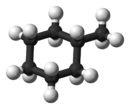- Methylcyclohexane
-
Methylcyclohexane 
 methylcyclohexaneOther namesHexahydrotoluene
methylcyclohexaneOther namesHexahydrotoluene
Cyclohexylmethane
Toluene hexahydrideIdentifiers CAS number 108-87-2 
PubChem 7962 ChemSpider 7674 
Jmol-3D images Image 1 - CC1CCCCC1
Properties Molecular formula C7H14 Molar mass 98.186 g/mol Appearance colorless liquid Density 0.77 g/cm3 Melting point -126.3 °C, 146.9 K
Boiling point 101 °C, 374 K
Solubility in water insoluble in water Hazards Main hazards severe fire hazard NFPA 704 Flash point -3 °C, 270 K  (verify) (what is:
(verify) (what is:  /
/ ?)
?)
Except where noted otherwise, data are given for materials in their standard state (at 25 °C, 100 kPa)Infobox references Methylcyclohexane is a colourless liquid with a faint benzene-like odour. Its molecular formula is C7H14. Methylcyclohexane is used in organic synthesis and as a solvent for cellulose ethers. It is a component of jet fuel and is also a component of correction fluids.
Contents
Structure
Monosubstituted methylcyclohexane has one methyl branch on one carbon of the cyclohexane ring. Like all substituted cyclohexanes, it can ring-flip rapidly between two chair conformations. However, a monosubstituted Methylcyclohexane exists almost exclusively in the equatorial position rather than axial. When the methyl group occupies the axial position, there is steric crowding (steric strain) by the axial hydrogens on the same side of the ring (known as the 1,3-diaxial interactions). There are two such interactions, with each methyl/hydrogen pair contributing approximately 7.61 kJ/mol strain. However, the equatorial conformation experiences no such interaction so it is more stable.
Disubstituted cyclohexanes
Main article: Cyclohexane conformationCyclohexanes could also have more than one methyl branch. Disubstituted cyclohexane, or also known as dimethylcyclohexane has two methyl branches. Unlike the monosubstituted cyclohexane, there are several possible structures. The methyl groups could be on the same carbon, separate carbons and it doesn't necessarily have to be on the same face. The 1,3-diaxial strain interactions still apply to the disubstituted. If the methyl groups are on different faces and both in axial positions, there are diaxial interactions with the axial hydrogen groups on both faces. If they are on the same face, both methyl groups interact with the one hydrogen that is in axial position and there is also a methyl-methyl interaction with a steric energy of approximately 15.3 kJ/mol. If the methyl groups are on adjacent carbons of the cyclohexane, with one of them axial and the other equatorial, there would be a gauche interaction which adds to the total strain energy the molecule has. For the dimethylcyclohexane which has two methyl groups on one carbon (1,1-dimethylcyclohexane), one methyl group is axial and the other equatorial. It would have the same total strain energy as the monosubstituted cyclohexane with axial methyl.
Jet Fuel Surrogates
Methylcyclohexane is one of a group of fuels that have recently been used as components for jet fuel surrogate blends [1]. Chemical analysis of Jet A finds a high cycloparaffin content; methylcyclohexane is one of the hydrocarbons used as Jet A surrogate in order to mimic this high presence of cycloparaffin and the associated chemical behaviour of the fuel.
References
- ^ Ji, C.; Egolfopoulos, F.N. (2011). "Hydrogen Flame propagation of mixtures of air with binary liquid fuel mixtures". Proc. Comb. Inst. 33: 955–961. doi:10.1016/j.proci.2010.06.085.
Categories:- Cycloalkanes
- Hydrocarbons
- Hydrocarbon solvents
Wikimedia Foundation. 2010.

